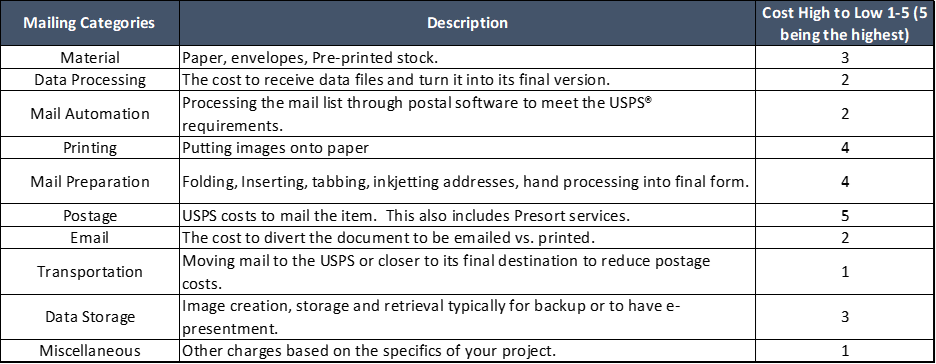I am going to start out with a blanket statement based on years of customer research: 99% of medium to large organizations have limited to no visibility to their mail spends across the enterprise. This leads to overspending, lack of control, and lost funds. The largest category of this overspending is around mail that is outsourced to third parties.
Most of the mail in the United States is not processed in local offices, but instead sent to outsourced print and mail services who have the proper equipment, staff, and expertise to do it efficiently. The issue is that this is one of the least understood categories, with the lowest level of visibility and the highest opportunity to overspend. When we analyze what organizations are paying for these services, we find huge discrepancies in the rates paid, the level of detail provided on invoices, and the lack of knowledge and visibility to the scope of the services being provided. This category can be in the hundreds of thousands to millions in annual spend and because of these issues, can have significant savings opportunities.
There are three key ways to reduce your costs with outsourced print and mail services, and each is equally important in your program’s optimization.
Visibility Is the Key to Success
To put the numbers in perspective, these outsourced providers, commonly known as mail houses, are processing over 70% of the nation’s 122 billion pieces of mail. This is a multi-billion-dollar industry made up of thousands of providers. Most organizations that we work with had limited to no visibility to what service providers they are using, the cost of the projects they are outsourcing, and the breakout detail of what was driving their rates. The reason is that the spend is typically fragmented with different groups creating projects, and these groups typically do not communicate. Some of the most common issues we see include:
· Statement and transaction print documents (Accounts Receivable)
· Advertising based projects (Marketing)
· Customer service information announcements (Customer Service/Operations)
· Internal staff mailings (Human Resources)
This visibility is made more difficult when there are multiple locations and lines of business all working with different outsourced providers. We recommend having one person or group take responsibility for managing this category holistically to have the understanding and data to create the leverage for change.
The level of visibility is difficult to manage because each vendor invoice has different degrees of detail. We have seen bills for large sums with a single line charge, while others break out every service area into multiple sub-groups that may be difficult to understand. You will find incredible variations in the rates charged from one job or service provider to another. Also, there can be significant overcharges because invoices are infrequently audited against a contract rate.
The key to reducing costs is to develop a standard process to build this visibility, to better understand your mailings and fees. We developed a system to categorize every charge into one of the mailing categories listed below. With this, you can now compare cost of services, providers, and the impact of changes.

Optimize How You Are Sending Your Mail
Now that you have the visibility to your mailings, you can develop strategies to reduce costs. The biggest savings potential is optimizing the way you are sending current projects using your existing providers.
· Postage is the largest cost of most mailings, making up over 50% of the spend. There are multiple strategies that can be utilized from moving mail closer to its destination, to USPS quarterly incentives, or consolidating spend under your own direct presort arrangements. There could be additional savings by changing from Flats to Letter or from First-Class Mail to Marketing Mail or validating that Full-Service IMb (Intelligent Mail Barcode) discounts are in effect. The key is having a person on your team that understands what is available and can push the service providers to optimize the spend.
· Printing is the next biggest area with large variations in costs. Ask the questions: Does everything have to be in color, can roll print be used instead of cut sheet, and is high-speed inkjet printing viable instead of laser? We recommend understanding your print costs to make sure you have benchmarks against your various service providers.
· Print suppression by converting to email or web presentment is one of the best ways to reduce costs. Understanding the full printing and mailing costs could provide a business case to offer incentives to clients who go electronic.
· Pay attention to the cost of image creation, storage, and presentment because this can grow drastically based on the longevity of images that are stored and accessed. By understanding the total cost of this spend, you have the means to decide if it makes sense to offload this work from the service providers to your own storage models.
· There can be savings in the remainder of the categories above based on having the details of how items are mailed.
Optimize Your Mail Service Providers
The final step is to make sure that you are using the best providers with the most competitive rates. With the data we have gained from the visibility step, you will see drastic rate variances between providers, and it is a best-in-class practice to do a request for proposal (RFP). This can be done on a project-by-project basis (if you do infrequent mailings), but a best practice is to develop national agreements with fewer providers where you can get higher service levels, account management, and lower costs. Here are items that are important when selecting a service:
· Where are your customers? If you mail locally, you will get faster delivery times if the service provider is in your area vs. needing to send across country. On the other side, if your customers are nationwide, you may want to look for providers with multiple mailing locations that can split projects to be closer to the customer. If you are going to mail from one location, is the service provider in the center of the country or near a USPS hub to provide better service levels? Finally, what is the cost of labor in your area? If you are in a high cost of living region, it may make sense to look at providers in less expensive parts of the country who can offer lower pricing.
· What type of mail are you sending? Some service providers focus on transactional mail like statements or invoices, while others focus on marketing projects. You may want to have different vendors for these different categories. Also, some providers may focus on a specific vertical like banking or insurance that can offer a higher level of service.
· What added value services will you need? Examples include creative, transportation, web presentment, storage of stock, or on-demand mailing services with online portals and third-party agreements with presort services and international remailers.
When creating the RFP, it is important to control the template so you can easily compare services. It is equally essential to know all the fee structures to your current projects to make sure they are represented. The biggest issue companies have is they focus on the cost to mail the one-page document and do not look at the other items we mentioned above that could have a significantly larger impact on the total cost. It is also valuable to be able have sections where each provider can discuss their visibility and support models as well as provide references.
Unfortunately, many mailers have limited to no visibility to their spends in this category. To make matters worse, many spend millions of dollars with these outsourcers and on permit accounts with limited controls or internal expertise. The good news is, with the proper resources and processes, this is one of the largest categories for savings as well as creating simplicity in its oversight and management.
Adam Lewenberg, CMDSS, MDC, President of Postal Advocate Inc., runs the largest Mail Audit and Recovery firm in the United States and Canada. They manage the biggest mail equipment fleet in the world and their mission is to help organizations with multi-locations reduce mail and parcel related expenses, recover lost postage funds, and simplify visibility and oversight. Since 2011, they have helped their clients save an average of 59% and over $63 million on equipment, presort, avoidable fees, and lost postage. He can be reached at 617.372.6853 or adam.lewenberg@postaladvocate.com.
This article originally appeared in the March/April, 2021 issue of Mailing Systems Technology.
















